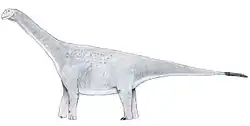| Jiangxititan Temporal range: Late Cretaceous, | |
|---|---|
 | |
| Scientific classification | |
| Domain: | Eukaryota |
| Kingdom: | Animalia |
| Phylum: | Chordata |
| Clade: | Dinosauria |
| Clade: | Saurischia |
| Clade: | †Sauropodomorpha |
| Clade: | †Sauropoda |
| Clade: | †Macronaria |
| Clade: | †Titanosauria |
| Clade: | †Lognkosauria |
| Genus: | †Jiangxititan Mo et al., 2023 |
| Species: | †J. ganzhouensis |
| Binomial name | |
| †Jiangxititan ganzhouensis Mo et al., 2023 | |
Jiangxititan is an extinct genus of titanosaurian sauropod dinosaur from the Late Cretaceous Nanxiong Formation of China. The genus contains a single species, J. ganzhouensis, known from several articulated vertebrae with ribs.[1]
Discovery and naming
The Jiangxititan holotype specimen, NHMG 034062, was discovered in sediments of the Nanxiong Formation near Tankou Town in Ganzhou City of Jiangxi Province, southern China. The specimen consists of the three posteriormost cervical vertebrae with two cervical ribs, articulated with the first four dorsal vertebrae with three dorsal ribs.[1]
In 2023, Mo et al. described Jiangxititan ganzhouensis as a new genus and species of lognkosaurian titanosaur based on these fossil remains. The generic name, "Jiangxititan", combines a reference to the type locality in Jiangxi Province with the word "titan", a common suffix for titanosaur names, referencing the pre-Olympian gods of Greek mythology. The specific name, "ganzhouensis", references the discovery of the fossil in Ganzhou City.[1]
Classification
Mo et al. (2023) recovered Jiangxititan as a derived member of the titanosaurian clade Lognkosauria, as the sister taxon to Mongolosaurus. The results of their phylogenetic analyses are shown in the cladogram below:[1]
| Titanosauria |
| ||||||||||||||||||||||||||||||||||||||||||||||||||||||||||||||||||||||||||||||||||||||||||||||||||||||||||||||||||||||||||||||||||||||||||||||||
References
- 1 2 3 4 Mo, Jin-You; Fu, Qiong-Yao; Yu, Yi-Lun; Xu, Xing (2023-09-21). "A New Titanosaurian Sauropod from the Upper Cretaceous of Jiangxi Province, Southern China". Historical Biology: 1–15. doi:10.1080/08912963.2023.2259413. ISSN 0891-2963.










